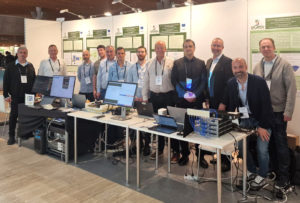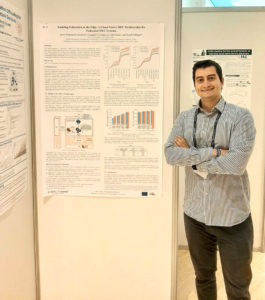
Keep up to date with our innovative initiatives.
Sign up here
Researchers from the i2CAT Foundation have participated in the new edition of the European Conference on Networks and Communications (EuCNC) and the 6G Summit, a flagship European conference supported by the European Commission, in the field of communication networks, hosted in Antwerp (Belgium) from the 3rd to 6th June. The motto for the 2024 EuCNC & 6G Summit has been “6G: From vision to reality”, and for another year, the conference brought together leaders, researchers, policymakers and industry pioneers from all over the world to engage in insightful discussions and share groundbreaking research in communication networks and associated topics, from the technical intricacies of 6G networks to social impact expected from this new communications paradigm.
Jesus Alonso-Zarate, Director of Research at the i2CAT Foundation, attended the event as a member of the Governing Board of the 6G Smart Networks and Services Industry Association (6G-IA). The association’s main objective is contributing to Europe’s leadership in 5G, 5G evolution, and 6G research.
 On Monday, Miguel Catalán, from the Mobile Wireless Internet research area, participated in the Workshop “From Open RAN to Open Networks for 5G and 6G Applications,” which showcased the innovations underway in BeGREEN, a 6G SNS JU project oriented toward developing an energy-efficient and sustainable network architecture in which the i2CAT researcher participates actively. Together with David Reiss, he also took part in the BeGREEN Intelligent Plane demonstration performed in the project’s booth during the conference. The BeGREEN Intelligent Plane consists of a novel framework that implements and exposes AI/ML workflows to O-RAN-based optimisations targeting energy efficiency. Finally, on Tuesday, Miguel Catalan intervened in the session entitled “Innovations in Resource Management, Beamforming Strategies, and Architectural Enhancements for Next-Generation Mobile Networks” to present the paper “BeGREEN Intelligent Plante for AI-driven Energy Efficient O-RAN Management”.
On Monday, Miguel Catalán, from the Mobile Wireless Internet research area, participated in the Workshop “From Open RAN to Open Networks for 5G and 6G Applications,” which showcased the innovations underway in BeGREEN, a 6G SNS JU project oriented toward developing an energy-efficient and sustainable network architecture in which the i2CAT researcher participates actively. Together with David Reiss, he also took part in the BeGREEN Intelligent Plane demonstration performed in the project’s booth during the conference. The BeGREEN Intelligent Plane consists of a novel framework that implements and exposes AI/ML workflows to O-RAN-based optimisations targeting energy efficiency. Finally, on Tuesday, Miguel Catalan intervened in the session entitled “Innovations in Resource Management, Beamforming Strategies, and Architectural Enhancements for Next-Generation Mobile Networks” to present the paper “BeGREEN Intelligent Plante for AI-driven Energy Efficient O-RAN Management”.
Still, on Monday, Joan Adrià Ruiz-de-Azua, director of the Space Communications research area, participated in the workshop “Non-Terrestrial Networks and Terrestrial Networks Unification—from Vision to Reality”, where he presented some advancements in the ETHER research project. This 6G SNS JU project will develop solutions for a Unified Radio Access Network (RAN) and energy-efficient, AI-enabled resource management across the terrestrial, aerial and space domains while creating business plans to drive future investments in the area.
On Tuesday, Jad Nasreddine, from the Mobile Wireless Internet research area, and Laura Sanz, from the Research and Innovation Strategy in Europe area, participated in the special sessión “From 5G to 6G Support for CAM (5G6GCAM)”. Jad Nasreddine conducted a presentation on “Target-X: Accelerating the Uptake of 5G for Automotive” to introduce some of the advancements performed within the 6G SNS JU project Target-X. Within this project, i2CAT leads Work Package 4, “Automotive”, to evaluate how challenges emerging from novel automotive use cases can be tackled with novel 6G concepts. By her side, Laura Sanz offered a presentation entitled “The 5G Strategic Deployment Agenda for Connected and Automated Mobility (5G SDA for CAM)”, in which she presented some of the results of the GUIDE research project, which aims to unite key stakeholders in the 5G Corridors ecosystem in the EU and coordinate the development of the 5G Strategic Deployment Agenda (SDA) for CAM. Jad Nasreddine also participated in the Target-X Demonstration of energy monitoring for robotic and construction use cases.

Also on Tuesday, Elena Fernández Niño, from the Space Communications research area, participated in the session “Advancements in Satellite-Aided Communications and Integrated Network Architectures for Next-Generation Telecommunications” to present the paper “A Case Study of a Hybrid RF and Optical Inter-Satellite Link Terminal to Enhance Optical Pointing”. The study proposes using a hybrid communications system to leverage the ability of the radiofrequency antennas to enhance the optical pointing system and reduce the pointing error.
On Wednesday, Xavier Costa, director of the AI-driven systems research area, participated in the special session “Towards new connected mobility”, reviewing the AI-driven technologies expected to shape 6G-enabled mobile systems, such as vehicles, drones and robots.
Javier Palomares, from the Software Networks research area, participated in the Poster Session to present the paper “Enabling Federation at the Edge: A Cloud-Native MEC Orchestrator for Federated MEC Systems”, which includes some of the advancements achieved within the Horizon Europe research project 6G-XR. The
 paper presents a cloud-native Multi-access Edge Computing Orchestrator (MEO) that enables seamless application lifecycle management and monitoring. The study confirms the orchestrator’s capability to deliver high-quality performance in diverse scenarios.
paper presents a cloud-native Multi-access Edge Computing Orchestrator (MEO) that enables seamless application lifecycle management and monitoring. The study confirms the orchestrator’s capability to deliver high-quality performance in diverse scenarios.
Finally, Javier Jordán, from the Space Communications research area, intervened in the session “Cutting-Edge Techniques and Applications in Quantum Communication, Reconfigurable Transceivers, and AI-Driven Networking for the 6G-Era” to present the paper “Evaluation Method and Case Study of satellite quantum key distribution for terrestrial networks”. The study includes some of the results of the UNICO I+D 6G research project 6GSatNet. Notably, the paper presents a method for performance evaluation of quantum key distribution (QKD) based on satellites, exemplified by a case study that considers small satellites (CubeSats) in low Earth orbits (LEO) to illustrate a flexible configuration of the quantum range extender use case.
EuCNC is a key event in the European R&I ecosystem. It has become a unique meeting point for researchers and organisations involved in the Smart Networks and Services Joint Undertaking (SNS-JU), the European R&D initiative directed at designing and facilitating technologies for the next generation of mobile networks and its advanced services.